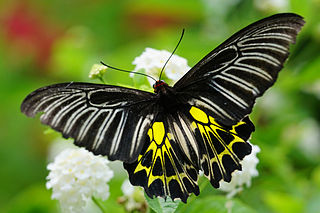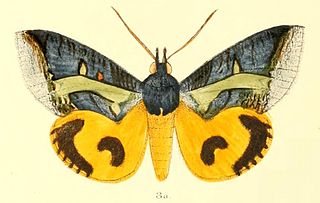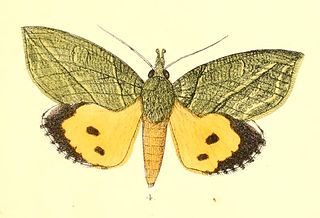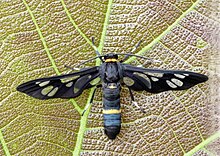
Parantica aglea, commonly known as the glassy tiger, is a butterfly found in the Indomalayan realm. The species is a member of the Danainae subfamily of the Nymphalidae family.

Papilio alcmenor, the redbreast, is a species of swallowtail butterfly found in South Asia.

Troides aeacus, the golden birdwing, is a large tropical butterfly belonging to the swallowtail family, Papilionidae.

Psilogramma menephron, the privet hawk moth or large brown hawkmoth, is a member of the family Sphingidae. It was described by Pieter Cramer in 1780. It is usually found in Sri Lanka, India, Nepal, central and southern China, Thailand, Vietnam, Indonesia and the Philippines. Psilogramma casuarinae from eastern Australia was long treated as a synonym but is now thought to be a distinct species. The introduced population on Hawaii was first thought to be P. menephron, but is Psilogramma increta.

Appias libythea, the striped albatross, is a small butterfly of the family Pieridae, that is, the yellows and whites, which is found in south and southeast Asia.

Miletus symethus, the great brownie, is a small butterfly found in India that belongs to the lycaenids or blues family. The species was first described by Pieter Cramer in 1777.

Hippotion celerio, the vine hawk-moth or silver-striped hawk-moth, is a moth of the family Sphingidae. It was described by Carl Linnaeus in his 1758 10th edition of Systema Naturae.

Nepita is a monotypic moth genus in the subfamily Arctiinae erected by Frederic Moore in 1860. Its only species, Nepita conferta, the footman moth, was first described by Francis Walker in 1854. It is found in India and Sri Lanka.
Spectroreta is a monotypic moth genus belonging to subfamily Drepaninae erected by Warren in 1903. Its only species, Spectroreta hyalodisca, was described by George Hampson in 1896.

Ercheia cyllaria is a species of moth of the family Erebidae first described by Pieter Cramer in 1779. It is found in the Indian subregion, Sri Lanka, Taiwan, Japan, Indochina, Thailand, Peninsular Malaysia, Sumatra, Borneo, Seram and the Kai Islands.

Trigonodes hyppasia, the triangles or semi-looper, is a moth in the family Erebidae. The species was first described by Pieter Cramer in 1779. It is largely cosmopolitan, found throughout Borneo, Fiji, India, Maldives, Nepal, Sri Lanka, São Tomé and Príncipe, Taiwan, Thailand, Zimbabwe, northern Australia, and almost all African countries.

Eudocima homaena is a moth of the family Erebidae first described by Jacob Hübner in 1816. It is found in the Indian subregion, Sri Lanka, Myanmar, Taiwan, the Nicobars, Peninsular Malaysia, Borneo, the Philippines and on Christmas Island. It is a major pest on orange plants.

Eudocima hypermnestra is a moth of the family Erebidae described by Pieter Cramer in 1780. It is found in China, Thailand, Taiwan, India and Sri Lanka.

Asota caricae, the tropical tiger moth, is a species of noctuoid moth in the family Erebidae. It is found from the Indo-Australian tropics of India and Sri Lanka to Queensland and Vanuatu.

Asota ficus is a moth in the family Erebidae first described by Johan Christian Fabricius in 1775. It is found in Afghanistan, Bangladesh, China, Taiwan, India, Indonesia (Sumatra), Laos, Myanmar, Nepal, Pakistan, Sri Lanka, Thailand and northern Vietnam.

Ischyja manlia is a species of moth of the family Noctuidae first described by Pieter Cramer in 1776. It is found in the Indian subregion, Sri Lanka, Myanmar, Thailand, China, Okinawa, Sundaland, Sulawesi, Korea, the southern Moluccas, Australia (Queensland) and Palau.

Eligma narcissus, the ailanthus defoliator, is a moth in the family Nolidae. The species was first described by Pieter Cramer in 1775. It is found in tropical Asia and the subtropics of China, India, Sri Lanka, Java and Southeast Islands.

Lacera alope, the toothed drab, is a moth of the family Erebidae. The species was first described by Pieter Cramer in 1780. It is found in Africa, where it is known from southern and eastern Africa, including several islands of the Indian Ocean, Saudi Arabia, and southern Asia from India, Sri Lanka to China.

Eressa confinis is a moth of the family Erebidae. It was described by Francis Walker in 1854. It is found in India, Bhutan, Sri Lanka, Myanmar, Taiwan and China.
Euchromia magna is a moth of the subfamily Arctiinae. It was described by Charles Swinhoe in 1891. It is found in India and Sri Lanka.



















